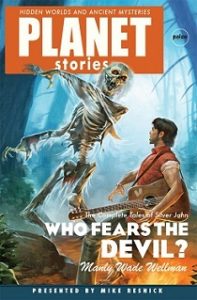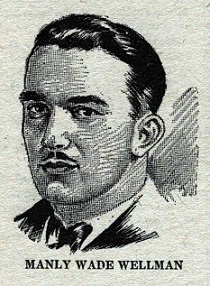
© Paizo Inc
Ahead of Halloween, here’s another reposting of something I wrote about a writer of spooky stories whom I like a lot. This time it’s Manly Wade Wellman, author of the ‘Silver John’ stories. This piece first appeared on this blog in 2016.
I’d heard the name of writer Manly Wade Wellman before. He was, for instance, one of the people to whom Stephen King dedicated his non-fiction book Dance Macabre back in 1982. But I was unfamiliar with his work until recently when I picked up a collection of his fantasy-horror fiction called Who Fears the Devil?, published in 2010, 24 years after Wellman’s death.
The short stories in Who Fears the Devil? are set in the Appalachian Mountains. Wellman evokes their wilderness areas and remote human settlements as vividly as, say, H.P. Lovecraft evokes the towns, woods and hills of New England that form a frequent backdrop to his tales, or Ray Bradbury evokes those neighbourly mid-western small towns, all porches and picket fences, that feature prominently in his work.
Wellman, a prolific writer of pulp detective, science fiction, horror and western fiction who also spent his later decades teaching at the University of North Carolina, captures the stark grandeur of this environment – dizzying mountains, mysterious forests, secluded valleys, frothing brooks and tumultuous waterfalls. He also nails the character of its human inhabitants. Their innocence and good-naturedness conveyed in the cadences of their speech. Practically every page of Wellman’s Appalachian stories seems to ring with unpretentious but pleasingly musical dialogue. His mountain characters trade such utterances as: “Do my possible best…”, “Won’t be no better singing and dancing the day these young ones marry up…”, “I’ve known men kill them themselves because she’d put her heart back in her pocket on them…”, “I’m right sorry…” and “I hear that somebody around here took a shot at my great-grandboy…” (There isn’t much innocence or good-naturedness conveyed in that last utterance, admittedly.)
Roaming these mountains, valleys and forests is Wellman’s most famous creation, Silver John, who earns a crust here and there as an itinerant singer and musician. John, who made his first appearance in 1951 in the Magazine of Fantasy and Science Fiction, is no simple-minded hick. Like many American men of his generation, he’s travelled – albeit in an unplanned manner, doing military service for Uncle Sam during World War II. He’s also well-read and learned, able to discuss Freud and Sir James Hopkins Jeans’ The Mysterious Universe (1930) when the need arises. And he’s similarly well-informed about the fields of folklore, superstition and the paranormal. This is just as well, because wherever he wanders, he seems to encounter trouble in the form of supernatural deities, mythical monsters and havoc-wreaking human dabblers in the occult.
Basically, Wellman’s Silver John stories are the adventures of a psychic investigator discovering, battling and defeating the forces of darkness, which come in different guises in each instalment. In effect, the John stories are The X-Files (1993-2018) without the FBI, the suits or the torturous alien / UFO conspiracy plot, or Scooby Doo (1969-present) without the meddling kids, the Scooby snacks or the Mystery Machine. Instead, they’ve got hillbillies, dungarees and lots of Appalachian folk songs and balladry.
There’s something supernatural about John himself. For one thing, whatever song he finds himself performing at the start of each story usually, spookily, prefigures or comments on the supernatural events that come later. Thus, when he sings Little Black Train (a song popularised in real life by Woody Guthrie) early on in a story of the same name, it’s no surprise that an appearance is soon made by a phantom, death-dealing black train: “The little black train is rolling in / To call for you tonight…”
John’s nickname, incidentally, comes from the strings on his guitar, which are made of silver. Supernatural creatures are known for not liking silver – silver bullets are the main way to kill a werewolf, for example. Thus, John is able on more than one occasion to ward off evil using his music. In the story O Ugly Bird! he even resorts to using his silver-stringed guitar as a club and just clobbers the monster with it.
There’s a bewildering variety of strange and creepy things going on in these stories. With its theme of unspeakable beings from other universes, One Other comes close to the science-fictional horrors of H.P. Lovecraft. Walk Like a Mountain deals with a giant who claims lineage from Biblical figures like Goliath and who’s also in the mould of John Henry, the super-strong railroad worker from 19th-century American folklore. On cue, Silver John starts playing a John Henry folksong on his guitar: “The mountain was high, the sun was low / John he laid down his hammer and died…”
Both Call Me from the Valley and Trill Coaster’s Burden feature old mountain customs and practices. Call Me includes a ‘dumb supper’, which is a midnight ritual enacted by young women as a way of conjuring up the image of the person they are destined to marry. And Trill is about ‘sin-eating’, which Silver John explains thus: “Somebody dies after a bad life, and a friend or paid person agrees that the sin will be his, not the dead one’s. It’s still done here and there, far back off from towns and main roads.”
Nobody Ever Goes There is an account of a weird, remote town divided in two by a river, where one half is populated and one half is deserted and where for some unspoken reason nobody from the populated half of town ever crosses the bridge to the unpopulated half. It’s worthy of an episode of The Twilight Zone (1959-64). Most outré of all, though, is The Desrick on Yandro, which postulates a whole ecosystem of undiscovered mythological creatures living on a remote North Carolina mountain: the Bammat, “something hairy-like, with big ears and a long wiggly nose and twisty white teeth sticking out of its mouth”, the Behinder, which can’t be described “for it’s always behind the man or woman it wants to grab,” the Skim, which just “kites through the air” and the Culverin, “that can shoot pebbles with its mouth.” Alas, once these fabulous beasties have done their turn in The Desrick on Yandro, they don’t reappear and aren’t mentioned again in Wellman’s stories.
Manly Wade Wellman’s writings about Silver John are richly imagined, utterly charming, hard to forget and unlike anything else I’ve read. Actually, they’re so rich and peculiar that it’s difficult to digest more than one or two of them in one sitting. It’s best to treat Who Fears the Devil? like a box of chocolates – not to be gorged on but to be dipped into occasionally, so that you have sufficient time to savour each of its treats.

From wikipedia.org / Wonder Stories
